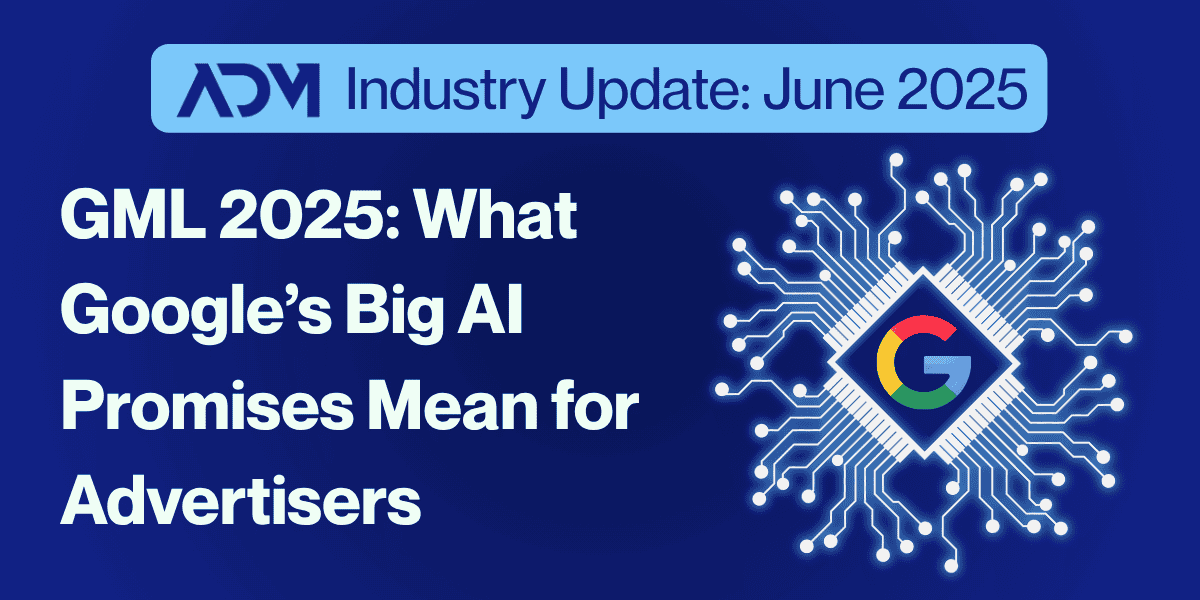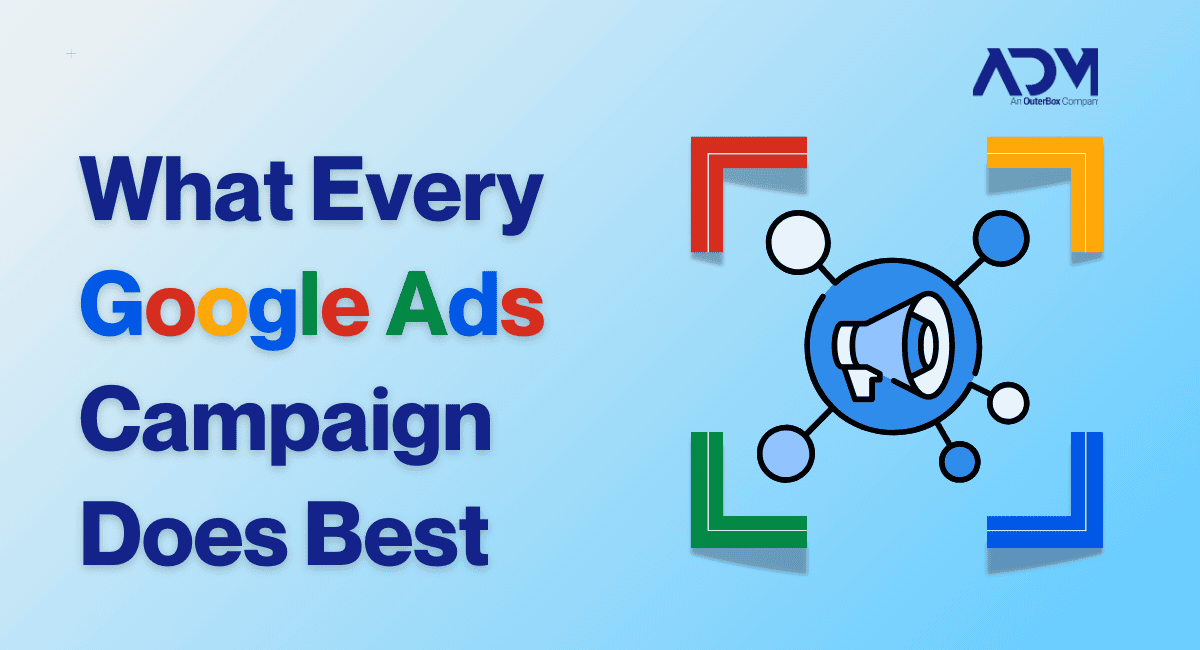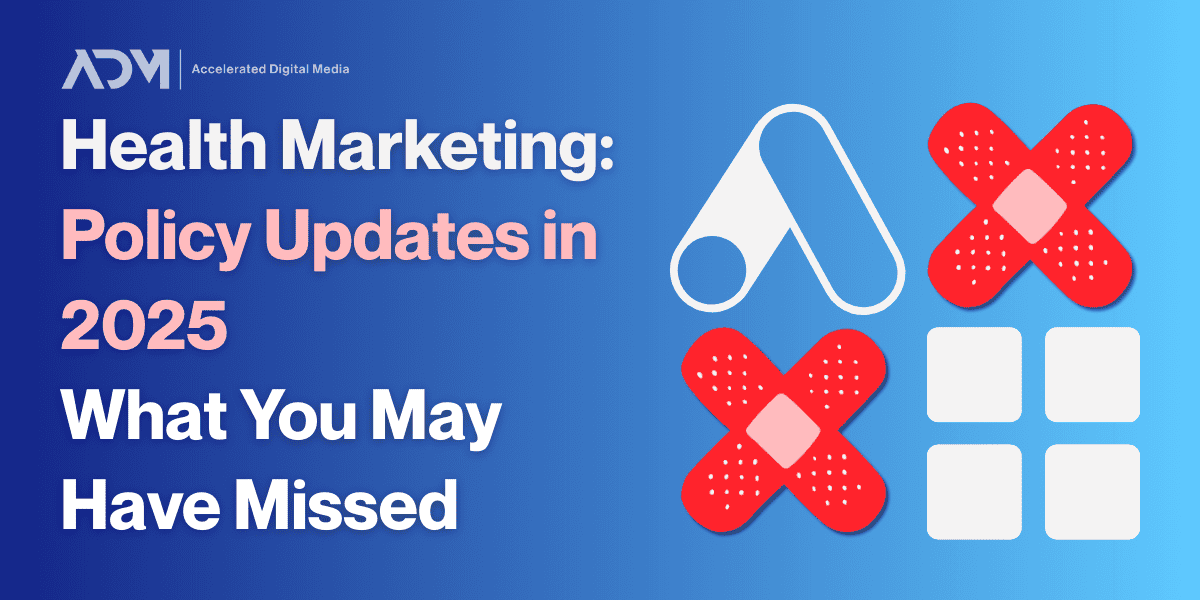At this year’s Google Marketing Live event, the major theme was once again AI—it underpinned the majority of new product and feature announcements. Google introduced an array of new tools covering nearly every corner of its advertising suite, with promises of improved performance, better traceability, and more transparency.
But it wasn’t just about shiny new tech. Google Marketing Live (GML) also focused on addressing digital marketing pain points, with or without AI. These include the lack of transparency sometimes associated with AI-powered campaigns; the difficulty of attributing success from Connected TV ads; and even the struggle to find content creators for influencer campaigns.
In this blog, we’ll explain the announcements Google made and highlight which we are most excited to test with our clients—while offering some considerations for how these developments could reshape Google Ads (and digital marketing in general) going forward.
Skip to Section:
- What Google Announced at GML
- The Google Ads Updates We’re Most Excited About
- What Advertisers Need to Consider
What Google Announced at GML
Google introduced a wide range of new tools, both user-facing and advertiser-specific. We’ll be testing them all and writing more about them in due time, but for now, here’s a brief primer on the key announcements (if you’ve already read all about them, feel free to skip ahead to our analysis):
AI Mode: Users are already being given the option to engage with Google’s AI mode, a new tab directly in the SERP that offers a more visual, interactive AI-powered search experience—with sponsored ads woven into it.
AI Max for Search: One of the more intriguing announcements at GML, AI Max is essentially a supercharged version of Dynamic Search Ads. It uses landing pages and site content to automatically generate ads and target queries based on user intent—even if you haven’t explicitly included those keywords in your account. This could help uncover incremental volume you may not have known to target, especially for long-tail or emerging queries.
Performance Max Visibility: Channel-level reporting for the most powerful Google Ads campaign type has now entered open beta, finally letting advertisers break out performance by Shopping, YouTube, Display, and other mediums.
Demand Gen Updates: Demand Gen campaigns will now offer more prospecting controls, giving advertisers more levers to guide upper-funnel performance. A customer acquisition goal is also on the way, which could help brands better optimize toward net-new users.
Shoppable Connected TV Ads: New Connected TV (CTV) ad units will let product feeds appear on-screen next to video ads, with a QR code allowing users to shop directly from their phones. This could make CTV placements much more interactive and create better engagement—ideal for reengaging high-intent audiences.
Full-Body Try It On: Of particular interest to apparel brands, Google’s recent, AI-powered virtual try-on tool now supports full-body previews.
Asset Studio Enhancements: Asset Studio now includes more tools to convert product images into video clips, generate seasonal creative, and resize content for various placements. The updates aim to streamline content creation and give marketers a faster path to higher-quality assets.
Creator Partnerships Hub: User-generated content (UGC) and creator collaborations have become a vital strand of online marketing, though most of that impact has been seen on social platforms like Meta and TikTok. Google is getting deeper in that game with a new hub to connect brands with creators via keywords—leveraging the vast creator population on YouTube to add more potency to your video ads.
Marketing Advisor: For advertiser support, Google Ads is adding a new chat-based troubleshooting tool built into the platform that can identify missing tags, suggest fixes, and provide setup guidance tailored to your CMS. While this may be most useful for in-house teams, it could help streamline quality assurance and get campaigns up and running faster.
The Google Ads Updates We’re Most Excited About
Among the many new features, several stood out to our team as being potentially of interest to our clients.
AI Max Could Be the Next Gamechanging Google Ads Campaign
AI Max seems like it could be a smart way to scale accounts. Dynamic Search Ad campaigns have historically performed well for our eCommerce clients, so this could represent a significant upgrade if it builds on that same intent-based targeting by incorporating even more signals. It’s intended to learn from your website and the other ads and details in your Google Ads account, so it could help fill in gaps in keyword targeting strategies, helping reach customers you may not have captured otherwise.
At first glance, AI Max seems to have the most potential for accounts with limited keyword coverage or teams that need to move fast. The ability to launch campaigns using existing content and assets opens up new surface area without requiring the same level of upfront keyword research and structuring. At the GML event, Google championed a case study that reported 27% more conversions at a similar ROAS compared to more traditional search campaigns. We don’t expect to see results that dramatic from the outset—but even a slice of that success would be a gamechanger
Added Performance Max Transparency is Welcome
New channel-level reporting for Performance Max might be the most immediately useful update. We’ve written in the past about the slight drawback that comes from the “black box” effect of AI-powered campaigns like Performance Max. While the results are usually strong, it’s crucially important to figure out what’s working in one campaign so you can apply those learnings elsewhere in your digital marketing efforts to strengthen your overall strategy. That hasn’t always been simple with Performance Max: ADM has had to use custom scripts to estimate how much spend is going toward Shopping versus Display (or any other medium that Performance Max serves).
This beta should make it easier to measure success in-platform, glean actionable insights, and hold Google’s algorithm accountable if it shows that ads have been serving in unintended or undesirable placements.
Shoppable Connected TV May Create Smoother Customer Journeys
If AI was the headline theme, streamlined and attributable user experiences were a key subtext. That was evidenced by the announcement of Shoppable CTV Ads, which once again address a drawback of a popular ad format.
CTV ads are great because they combine the captive and creative nature of TV advertising with the targeting precision that only digital marketing can allow. But a challenge is always encouraging and tracking next steps after a viewer sees the ad. The expectation is that interested viewers will look up your company on another device, like their phone, but that search is independent of the ad impression and difficult to accurately attribute.
With the ad playing on the TV, users will see the shopping feed beside it with QR codes or buttons to send the links to your phone. That creates an easy user flow from device to device. For our team, that’s pretty exciting—and we think it could be especially useful for reengaging audiences that have interacted with a brand, but haven’t purchased.
Expanded Creative Tools to Unlock Collaborations
Google also expanded creative capabilities with Asset Studio updates. These include tools that generate professional imagery, resize assets, convert product images into video clips, and offer seasonal creative suggestions. These are all exciting in their own right—even something as simple as a properly-sized and cropped image asset can make a huge difference in ad appeal and success.
But while those updates build on things that Google was already offering, the Creator Partnerships Hub is something new. User-generated content and influencer collaborations are highly-effective. But we find that one of the biggest challenges our clients face is connecting with the right creators and getting that content produced. Given that Google owns YouTube, it has access and data on millions of YouTube creators and channels—so it could streamline the process by helping identifying creators by keyword or genre, offering accurate viewing metrics, and estimating partnership costs. We think this is an exciting step toward making that ecosystem more transparent and easier to navigate.
What Advertisers Need to Consider
While these innovations offer exciting new ways to reach customers and optimize campaigns, there are important factors advertisers must keep in mind while approaching new and novel adtech.
AI Marketing Tools Require Better Inputs
The adage in data science is “garbage in, garbage out,” and that’s going to be especially true as more and more AI tools become available to marketers. More than ever, success in Google Ads will depend on the quality of your inputs. Landing pages, product feeds, and creative assets all inform how well these AI tools perform. If you’re using AI tools to create new creative assets from existing ones, the originals need to be top-quality. If AI Max is basing your search coverage and ads on your website, everything there needs to be accurate to your brand and products.
So while marketers work to master these new tools, they’ll need to coordinate closely with creative and design teams to ensure the AI isn’t set up for failure. AI can amplify the effectiveness of your campaigns—but it can’t overcome weak data or poor creative. Investing in high-quality assets and product information will be critical.
AI Expansion is Changing Both Paid Search and SEO
Chatbots have been depressing site traffic across the internet, and functions like new multimedia integrations and AI Mode will further that. The search engine results page (SERP) has already become a more visual, interactive experience that responds to queries with summaries and sponsored suggestions, so the way users engage with text links seems to already be shifting.
This has huge implications for organic links, but since the original function of a paid search ad was to sit alongside and mirror organic links, it will likely change how those perform as well. While Google has indicated that there will be advertising opportunities in AI Mode, we’ll be anxiously watching how this rolls out, how ads appear in that experience, and how users end up responding to them.
Managing Early Adoption and Learning Curves
When adopting new marketing tools of any type, there’s always a learning curve for the operator. AI-powered tools also take time to refine themselves: The algorithms need to process a large amount of data to improve overall and in any individual account. For something like AI Max, this means campaigns should require plenty of active management early on. As was the case with Performance Max, we expect these campaigns to continually become more effective over time.
Choosing to be an early adopter depends on each brand’s budget and its appetite for testing. There’s the possibility of growing pains, but there’s also an opportunity to create competitive advantages by integrating new techniques earlier. At ADM, we’re fortunate to have built long and trusting partnerships with many clients who embrace testing the latest Google Ads innovations in their accounts. It’s part of how we keep them ahead of their competitors and develop our internal best practices for these tools to apply them across our broader portfolio.
Whether you’re looking to test new approaches in your accounts or simply reap the benefits of working with a Google Ads Agency that always stays ahead of the curve, consider reaching out to ADM for a consultation.



